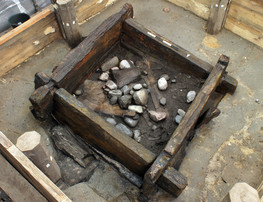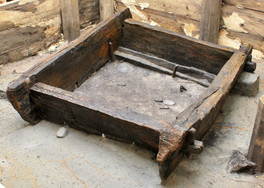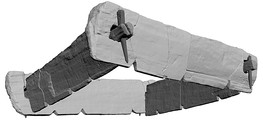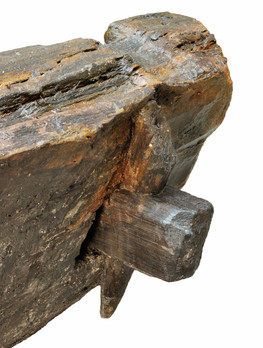A team of scientists from the University of Freiburg have dated and documented highly-developed construction techniques of wells built by early neolithic settlers.

The 7000-year-old well during the excavation.
With the help of dendrochronology or growth ring dating, a research team led by Willy Tegel and Dr. Dietrich Hakelberg from the Institute for Forest Growth of the University of Freiburg has succeeded in precisely dating four water wells built by the first Central European agricultural civilisation . The wells were excavated at settlements in the Greater Leipzig region and are the oldest known timber constructions in the world. They were built by the Linear Pottery culture, which existed from roughly 5600 to 4900 BC. The team's findings, which have been published in the international scientific journal PLoS ONE, afford new insight into prehistoric technology.

Relatively sophisticated log construction became evident during the excavation.
Wells were constructed from oak
The four early Neolithic wells were constructed from oak wood. In addition to the timber, many other waterlogged organic materials, such as plant remains, wooden artifacts, bark vessels, and bast fiber cords, as well as an array of richly decorated ceramic vessels, have survived for millennia hermetically sealed below groundwater level. With the help of dendrochronology, the scientists were able to determine the exact felling years of the trees and thus also the approximate time at which the wells were constructed. The tests revealed that the wood comes from massive old oak trees felled by early Neolithic farmers with stone adzes between the years of 5206 and 5098 BC. The farmers cleaved the trunks into boards, assembling them to make chest-like well linings with complex corner joints. Using state-of-the-art laser scanning technology, the scientists collected data on the timbers and tool marks and documented the highly developed woodworking skills of the early Neolithic settlers. The very well-preserved tool marks and timber joints testify to unexpectedly sophisticated timber construction techniques.

The base frame of one of the 7000-year-old wells.
Developed woodworking technology enabled a sedentary lifestyle
In the course of the sixth millennium BC, the nomadic hunting and gathering lifestyle gave way to a sedentary lifestyle with agriculture and stock breeding in Central Europe. This break in the history of mankind has been termed the "Neolithic Revolution." A sedentary lifestyle required permanent housing, and houses are inconceivable without a developed woodworking technology - in other words, the first farmers were also the first carpenters. Until now, however, archaeologists have only succeeded in unearthing the soil marks left by their houses. The precisely dated wells will enable scientists to conduct more detailed studies on the important role of timber construction techniques for mankind's adoption of a sedentary lifestyle.

Laser scanning image of the base frame showing the mortise and tenon corner joints.

The corner joints consist of a projecting piece of wood fed through a hole in the plank and secured with a wooden nail.
The study was conducted by archaeologists and dendrochronologists from the Institute for Forest Growth in Freiburg, the Archaeological Heritage Office of Saxony in Dresden, and the Swiss Federal Research Institute WSL in Birmensdorf, Switzerland.
If you'd like more information, contact:
Willy Tegel
Institute for Forest Growth
University of Freiburg
Phone: +49 (0)761 / 203-8591
E-Mail: tegel@dendro.de
